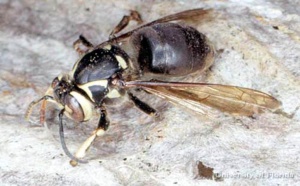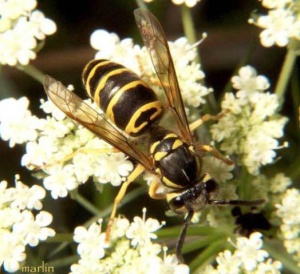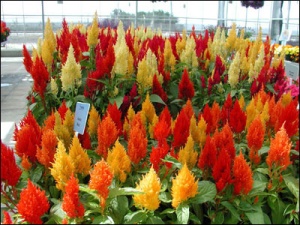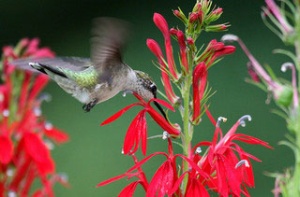A: Florida has two yellowjackets: eastern yellowjacket, Vespula maculifrons and the southern yellowjacket, Vespula squamosa. One species of hornet is also present: the baldfaced hornet, Dolichovespula maculata. The baldfaced hornet is actually a yellowjacket. It receives its common name “baldfaced” because it has a black colored body with a white face. Similar to most other hornets, it makes its nest above ground. In general, the term “hornet” is used for species which nest above ground and the term “yellowjacket” for those which make underground nests. Similar to bees, hornets and yellowjackets are social and live in colonies of hundreds to thousands of individuals. There are exceptions of yellowjackets making above ground nests which compounds the ability to truly make a definite distinction between yellowjackets and hornets. However, the coloration between the yellowjackets and the hornets in Florida are very obvious with the hornet having no yellow coloring on the body. All three of these wasps are important predators as they kill many insects attacking important landscape ornamental plants. However, nests near homes may prove a source of irritation and concern. If the nests are large or difficult to approach, for example within the walls of a house, the safest procedure would be to hire a pest control operator to eliminate the colony. If you already employ a pesticide service – call them first. However, it is important to note – not all pesticide companies will handle yellowjackets because of their aggressive nature if the alarm pheromone is released. If you decide to handle the destruction of the nest yourself, please do it after sunset when the wasps are inactive. It is critical to wear protective clothing. Even though the wasps are somewhat inactive at night, if disturbed, the alarm pheromone or scent can alert the hive and all wasps will come to the defense of one. Unlike honeybees, which die after they sting one time, wasps can sting multiple times. Yellowjackets and hornets are also attracted to sugar sources, such as berries and flower nectars. This can become a problem when the sugar source is a food or drink being consumed by a human. Sweet items like soft drinks, ripened fruits and watermelons attract bees and wasps. Keep these items covered outdoors. Pick fruit as it ripens and dispose of rotten fruits (Koehler and Oi 2003). In school yards, parks, and other community areas ensure lids on trash containers are either secure or able to prevent access by wasps as this potential food source (discarded drink containers, fruit remains, etc.) can attract wasps on a continual basis, leading to stinging incidents. This information was taken from a University of Florida publication titled: “Yellowjackets and Hornets.” https://edis.ifas.ufl.edu/in238
Monthly Archives: March 2016
Q: My grandmother just received something called Cockscomb as a gift from a visitor while she is in rehabilitation. What do we do with it?
A: Celosia has two types of flowers, the cockscomb, Celosia cristata and the plume types, Celosia plumosa. The tight, velvety texture of the cockscomb flowers look like brain tissue to some people. The fluffy, light, airy texture of the plume types blow freely in a breeze and are planted more often. Both come in a variety of colors. It is an annual and can be planted outside once she returns home. It usually grows no taller than 1 – 2 feet. Celosia plants love full sun so be sure to put it in the window so it can get as much light as possible. Although once it is planted outside, it will tolerate some shade. The soil should be kept moist but not wet. Once she gets back home, she can plant any of the following along with her gift: Cristata cultivars include the dwarf ‘Jewel Box’ and ‘Olympia’ series and the taller (18 to 24 inches) ‘Floradale’ and ‘Chief’ series. Plumosa series and cultivars include the dwarf ‘Kimono’ and ‘Geisha’ series and the taller types including ‘Apricot Brandy’, ‘Castle’ series, ‘Century’ series, ‘Forest Fire’ and ‘New Look’.
Q: When do hummingbirds come to Florida?
A: Well, the arrival of hummingbirds varies slightly from year to year, especially here in Northeast Florida. We generally say spring but those dates can range anytime in the month of March. The hummingbirds leave us in September. But here it is, early March and I saw my first hummingbird. The red flowers of the red buckeye tree are abundant in my yard and they are already providing nectar for the hummingbirds. The male hummingbirds arrive first and the females follow about a week later. Nests are often built near water with two eggs per nest. It takes about 20 days to incubate and about 4 weeks for the babies to mature and leave the nest. Baby hummingbirds are fed insects by parents but once they leave the nest they consume mostly nectar. One hummingbird may require nectar from hundreds of blossoms every day to maintain its body weight. While it is fun to put out hummingbird feeders (I have one in my yard too), we would also recommend planting flowing trees and shrubs to provide natural sources of nectar and nesting sites. Some good choices are bottlebrush, firecracker, firebush, firespike, salvia, red buckeye, etc. If you want to make your own nectar then take 1 part white, granulated, cane sugar to 4 parts water. Boil the sugar solution to help dissolve the sugar. Then allow it to cool before filling a feeder. This concentration is about the same as wildflower nectar. Using a sweeter solution, sugar substitutes or honey could be lethal to hummingbirds. It also is not necessary to add red food coloring. The birds will be attracted to the red feeders. Here in Florida, you may need to change the feeder several times a week as the temperatures increase. It is important to not allow the solution to ferment. Clean the feeders with hot water and white vinegar but do not use soap or chlorine bleach. If you have several hummingbird feeders, then it is best to keep the feeders at least 10 feet apart as these birds can be territorial.




